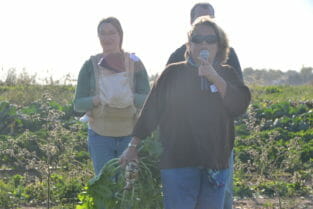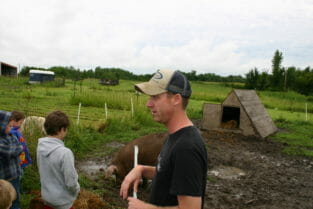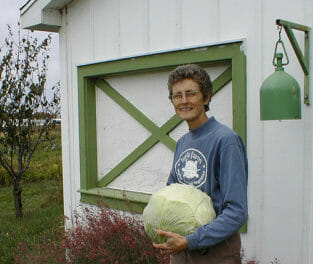From Greens to Meat Cuts: Farmers Share Tips on Preparing Local Foods Products
The 2016 spring issue of “the Practical Farmer” featured an article in which four PFI farmers shared their experiences direct-marking local foods products to customers that proved to be opportunities to help expand their customers’ culinary horizons.
The article — “From Daikons to Deer Hunters: Expanding Horizons Through Local Foods” — included insights from Laura Krouse, of Abbe Hills Farm; Ethan Book, of Crooked Gap Farm; Angela Tedesco, who until retiring from farming, operated Turtle Farm; and Steve Cassabaum, of Trinity Farms.
As a supplement to that article, this blog post highlights some preparation tips and other insights from these farmers about working with the local foods items discussed in the article. (Note: If you aren’t a member or don’t have the spring issue at hand, we’ll have a PDF copy available at practicalfarmers.org in another week or two.) Now that the growing season is getting into high gear, it’s a perfect time to try some of these new foods and put these preparation tips into practice!
Laura Krouse: Demystifying the Daikon

Laura Krouse holds a large daikon radish at her October 2015 PFI field day.
Laura raises corn, hay, oats and about 100 varieties of garden crops at Abbe Hills Farm, near Mount Vernon. She says that in her experience marketing through a CSA, customers are often resistant to members of the brassica family, including radishes, kohlrabi, salad turnips and Asian greens.
One radish in particular — the daikon — has been a source of consternation among customers who have never tried it. Daikons encompass a broad family of Asian radishes. The most common is a cylindrical, white-fleshed variety that can grow much bigger than other kinds of radishes. Laura thinks the sheer size and fear of spiciness are what scare people.
How to prepare? If you’re new to daikons, Laura suggests you try them raw first, to learn how they taste. But she adds these radishes are actually much more versatile.
Besides being an excellent addition to slaws and sandwiches, “you can also pickle them, put them in meatloaf or stir fries, add them to mashed potatoes or make creamed radish. Many Asian recipes also call for daikon radish.”
For those who still aren’t sure, Laura suggests dipping pieces in hummus or ranch. “Everything is edible dipped in ranch,” Laura says, “so that’s a good place for people to start with a vegetable they don’t know.”
Ethan Book: Grass-Fed and Unusual Meat Cuts

Ethan Book speaks at a field day.
Ethan and his wife, Rebecca, raise pastured and grass-fed heritage and rare breeds of pork, beef, lamb and poultry at Crooked Gap Farm, near Knoxville. They operate a meat CSA, market whole- and half-hogs and sell individual meat cuts (in addition to selling to some local restaurants). These marketing options provide unique opportunities for customers to try cuts of meat not commonly seen in a grocer’s meat case or frozen foods aisle. Ethan says those less common cuts tend to be the ones customers are more hesitant to try.
Here are some of the products the Books offer, and Ethan’s advice on working with them:
- Bacon ends: Ethan says he and Rebecca recently had bacon ends “piling up in the freezer” from various rounds of animal processing, so they decided to start including those in customers’ CSA shares from time to time. “Everybody knows how to prepare bacon, but people might be flummoxed by bacon ends.” Ideas: “We shared recipes for egg casserole, or different soup recipes,” Ethan says, highlighting how bacon ends can be a good flavoring ingredient.
- The anatomy of meat cuts: One challenge for some customers is understanding where certain meat cuts originate on the animal, Ethan explains, and how that relates to the quantity of a cut that will be available.
“In Iowa, I’d say we’re pretty pork-literate, as far as the general cuts like the loin, side and legs. The difficulty is understanding if you get bone-in chops from both sides of a hog, you’re not going to get any back ribs. You can still get spare ribs, but not back ribs. Or if you get cottage bacon, that will take away from the shoulder. Or if you want a lot of packages of loin, you probably won’t get a lot of loin roasts.
“For a customer purchasing a whole- or half-hog for the first time, we try to help them understand where those cuts come from, and that there’s a finite amount.”
- Different cooking technique for grass-fed: The grass-fed part of their business is one area where the Books have found they need to offer extra guidance. “I hate to make generalizations – some people have some really good beef or lamb genetics that marble really well — but generally speaking, grass-fed meats are going to be more lean, and so will possibly not have as much moisture when you’re cooking them. If you cook really hot, really fast, the meat has a tendency to dry out faster. We encourage people to cook slow and low.”
- Fresh pork shanks: Ethan says this is “one cut my wife has mastered. It gets used all over the place.” Ideas: Try canning it for pantry storage, use it in fajitas or as a main ingredient in rice dishes.
Ethan explains that shanks originate below the pig’s shoulder: “It’s got a bigger bone in the middle but still has plenty of meat around it — not as much meat as the shoulder, but a good, tender meat. If you’ve heard expression “living high on the hog,” that’s where the loin is the prize cut, in some ways, used for tender pork chops and roasts. As you work your way down the hog you run into more fat and bigger bones, like pork shanks.”
Angela Tedesco: Greens and Edible Weeds

Angela Tedesco operated Turtle Farm near Granger, until retiring in 2012.
Until retiring in 2012, Angela operated Turtle Farm near Granger, where she grew a range of organic vegetables, fruits and herbs for her CSA. She recalls how “the most challenging foods customers needed help with seemed to be how to cook greens of all sorts, from kale to collards.”
A simple recipe: To help inspire her customers, Angela included recipes for greens in her CSA newsletter. But her favorite recipe is a simple one that can be used with all sorts of greens, and can be easily tweaked with different herbs or spices:
“My favorite recipe for greens is to slowly cook a sliced clove of garlic in your oil of choice for about a minute in a large skillet. Then add in the cleaned, coarsely chopped greens (stems removed, if tough), and add 1/4 to 1/2 cup of water. Cover and steam in the skillet until tender. Season with salt to taste. You could add some additional spices, such as red pepper flakes (or others).”
Edible Weeds: Angela also grew up harvesting and cooking wild pokeweed greens (caution: only the greens are edible; NOT the poke berries, which are poisonous). For her CSA, she would harvest wild nettles to share with her customers. She offers these tips on working with edible weeds:
“The pokeweed berries are considered poisonous — and we always cooked the greens in water and then poured off the first cooking water. We added more water, cooked a bit more, then served the poke greens with vinegar.”
Nettles also need to be blanched in boiling water to deactivate the stinging hairs, and can then be used in a variety of ways. When sourcing, Angela says: “One should always be concerned about your source when wild-harvesting. I harvest nettles from my farm and from my backyard, so I know they are safe from pesticides.”
As always when harvesting wild edibles, make sure you’re allowed to harvest from a particular area — and practice good stewardship (not taking too much), so the plants can thrive into the future!
For more of Angela’s recipe ideas, visit http://www.turtle-farm.com/Recipes/index.htm.
Steve Cassabaum: Carcass Weights + Beef Bundle Explained
Steve and his wife, Michelle, raise grass-fed beef and lamb, along with pastured pork, at Trinity Farms near Nevada. They direct-market bulk and individual cuts, and sell through Wheatsfield Co-op in Ames, Gateway Market in Des Moines and a few restaurants.
Steve echoes Ethan’s experience that new customers buying meat directly from him might feel thoroughly confused by the cut options, as well as the process of working through a local meat locker. “Many people have no idea how they might want to cut up or butcher a half- hog, -lamb or -beef. And trying to understand the processing fees of the locker, plus the cost per pound that the provider or farmer would charge, are other questions.
Carcass weight = hanging weight: Steve explains that the terms “carcass weight” and “hanging weight” are two phrases that can be used interchangeably. They both describe the weight after the butchered animal has been dressed (various parts removed), rather than the weight of a whole, live animal. “Hanging weight is the same as carcass weight. On our farm, we usually charge so much per pound hanging weight. What this refers to is once the animal has been gutted, the skin taken off and the head taken off, what’s left is called the hanging or carcass weight.”
Steve also explains that the quantity of meat you get back from the locker might sound like more than it will be in practice. To illustrate, he says: “We have a beef bundle, which is an eighth of a cow — about 40 pounds of beef, give or take — which will essentially fit pretty comfortably in a refrigerator freezer, or a small freezer.”
